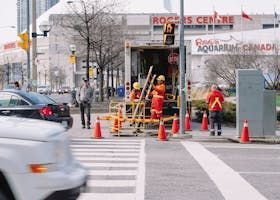California's wildfire crisis has created a two-tiered real estate market where properties in Very High Fire Hazard Severity Zones (VHFHSZ) trade at 10-15% discounts compared to similar properties in lower-risk areas. With over $40 billion in at-risk property values and major insurers restricting coverage, fire zone designation now fundamentally determines property accessibility, insurance availability, and long-term market viability across the state.
The convergence of climate-driven fire risks, insurance market disruptions, and housing shortage pressures has created unprecedented challenges for property owners, buyers, and investors navigating fire-prone areas. This market transformation extends beyond simple price adjustments, fundamentally altering how Californians approach homeownership, investment strategies, and long-term residential planning in fire-prone regions.
Current Fire Zone Classifications Transform Property Landscapes
California's Very High Fire Hazard Severity Zones (VHFHSZ) now encompass approximately 31% of the state's privately-owned land, affecting millions of properties across key metropolitan areas. CAL FIRE's risk assessment methodology continues evolving, incorporating climate projections, vegetation patterns, and historical fire behavior to refine zone boundaries. Recent updates have expanded VHFHSZ designations in previously moderate-risk areas, particularly affecting foothill communities and urban-wildland interface zones.
The state's fire hazard mapping system divides risk into three primary categories: moderate, high, and very high fire hazard severity zones. Properties within VHFHSZ face the most stringent building requirements, disclosure obligations, and insurance challenges. These designations directly impact property development potential, construction costs, and long-term market viability.
Emerging risk factors increasingly influence zone classifications, including drought patterns, bark beetle infestations, and changing precipitation cycles. CAL FIRE's modeling now incorporates 30-year climate projections, meaning current moderate-risk areas may face reclassification as conditions evolve. This dynamic assessment approach creates ongoing uncertainty for property owners and developers planning long-term investments.
Zone Classification Methodology and Updates
CAL FIRE utilizes sophisticated modeling that evaluates terrain, weather patterns, fuel loads, and fire history to determine hazard severity zones. The classification system considers factors including slope steepness, aspect orientation, fuel moisture content, and historical wind patterns. Properties receiving VHFHSZ designation must comply with specific building codes, vegetation management requirements, and enhanced disclosure obligations during real estate transactions.
Recent methodology updates incorporate climate change projections and emerging fire behavior patterns observed during recent catastrophic wildfire seasons. Areas previously considered moderate risk now face potential reclassification as temperature increases and precipitation patterns shift. This evolving assessment framework means property owners must monitor potential zone changes that could affect insurance availability and property values.
Property Values Show Dramatic Divergence Across Risk Zones
The financial impact of fire zone designation has created a bifurcated real estate market throughout California. Properties in VHFHSZ typically trade at 10-15% discounts compared to similar properties in lower-risk areas, though this gap varies significantly by region and property type. Premium locations with exceptional views or amenities may maintain values despite fire risk, while standard residential properties face more substantial discounts.
Market data reveals striking differences in sales velocity between fire and non-fire zones. Properties in high-risk areas average 25-30% longer market times, with buyers increasingly cautious about insurance availability and long-term ownership costs. The most significant value impacts occur in areas where recent fires have demonstrated actual risk rather than theoretical hazard.
Luxury properties show more resilience to fire risk discounting, particularly in established markets like Malibu, Napa Valley, and Santa Barbara foothills. Wealthy buyers often accept fire risk in exchange for privacy, views, and acreage, viewing insurance costs as manageable expenses. However, even luxury segments show increasing sensitivity to insurance availability, with some ultra-high-value properties becoming effectively uninsurable at any price.
Regional Value Impact Analysis
The scale of value impact varies considerably across California's diverse real estate markets. Coastal fire zones typically maintain higher baseline values due to location desirability, but face steeper percentage discounts when fire risk becomes apparent. Interior and foothill markets show more dramatic absolute value impacts, particularly where fire risk represents the primary market concern rather than one factor among many.
Recent wildfire events create immediate market impacts in surrounding areas, even where properties escaped direct damage. The psychological impact of nearby fire activity often produces 5-10% temporary value decreases while insurance availability issues create longer-term market pressure. Recovery patterns depend heavily on post-fire community rebuilding efforts and insurance market stabilization.
County Markets Exhibit Distinct Fire Risk Patterns
Los Angeles County presents the most complex fire zone real estate dynamics, with over 1.2 million properties in VHFHSZ across diverse communities from Malibu to La Crescenta. The county's market shows sharp value differentials between fire-prone canyon areas and safer valley locations, with some foothill communities experiencing 20-25% value discounts compared to nearby low-risk areas.
Orange County's fire zone properties concentrate primarily in eastern foothill communities like Anaheim Hills and Yorba Linda, where recent fire history creates acute insurance challenges. The county's higher average property values amplify the absolute dollar impact of fire risk discounting, making insurance availability critical for market stability.
Riverside and San Bernardino counties face unique challenges as desert fire risks increase with climate change and development pressure. Previously considered lower fire risk compared to coastal counties, desert communities now confront growing insurance premiums and availability issues as vegetation patterns shift and heat dome events become more frequent.
Wine Country Market Dynamics
Napa and Sonoma counties represent ground zero for fire impact on premium real estate markets. These wine country regions have experienced repeated catastrophic fires, creating sophisticated local markets where buyers and sellers understand fire risk pricing intimately. Properties with defensible space and fire-resistant features command premiums, while locations with demonstrated vulnerability face significant discounts.
Ventura and Santa Barbara counties demonstrate how coastal proximity affects fire zone markets differently than interior locations. Ocean influence moderates some fire risks while creating unique wind patterns that can accelerate fire spread. These factors create complex local market dynamics where micro-location becomes critically important for value determination.
Insurance Market Upheaval Drives Transaction Complexity
California's property insurance market has experienced unprecedented disruption, with major carriers restricting or eliminating coverage in high-fire-risk areas. State Farm, Allstate, and other major insurers have imposed moratoriums on new policies in VHFHSZ, forcing property owners toward specialty carriers or the California FAIR Plan residual market.
Insurance premium increases of 20-40% annually have become common in fire-prone areas, with some properties facing premium costs exceeding 1% of property value annually. This insurance inflation creates ongoing affordability challenges for existing homeowners while deterring potential buyers who cannot secure affordable coverage.
The California FAIR Plan, designed as insurer of last resort, now covers over 400,000 properties statewide, representing a four-fold increase from pre-2017 levels. FAIR Plan coverage typically costs 2-3 times standard market rates while providing more limited protection, creating additional financial burden for fire zone property owners.
Lender Response and Credit Market Impact
Mortgage lenders increasingly scrutinize insurance availability and costs during underwriting, with some institutions requiring additional reserves or imposing lending restrictions in high-risk areas. This tightening credit environment compounds market challenges by limiting buyer financing options in already-constrained fire zone markets.
Some lenders now require insurance quotes before final loan approval in VHFHSZ properties, adding transaction complexity and potential deal failure points. The combination of limited insurance availability and lender caution creates financing challenges that further depress fire zone property values and market activity.
Regulatory Changes Reshape Development Patterns
California's evolving building codes and disclosure requirements continue adapting to escalating fire risks. Assembly Bill 38 and related legislation mandate enhanced disclosure of fire risk and insurance availability for residential transactions, requiring sellers to provide detailed fire zone information and insurance claims history.
New construction standards emphasize defensible space requirements, fire-resistant building materials, and evacuation route planning. Communities within VHFHSZ must demonstrate adequate emergency access and water supply capacity before approving new development. These requirements add $15,000-$25,000 to typical single-family home construction costs while extending permit timelines.
Local jurisdictions increasingly adopt more restrictive zoning and development standards in fire-prone areas. Some counties limit density in high-risk zones, require additional setbacks from vegetation, or mandate community-wide fire prevention measures. These regulatory approaches aim to reduce risk but often increase housing costs and limit supply in already-constrained markets.
Infrastructure and Utility Planning Requirements
Senate Bill 1241 requires utilities to consider fire risk in infrastructure planning, potentially limiting service expansion in very high-risk areas. This utility planning coordination could restrict future development potential in some fire zone locations while encouraging more concentrated development in lower-risk areas.
Water system requirements for fire protection have become increasingly stringent, with some communities requiring dedicated fire suppression water storage and high-pressure delivery systems. These infrastructure investments can cost $5,000-$15,000 per home while providing insurance premium benefits and enhanced safety.
Market Adaptation Strategies Emerge Across Segments
Buyers increasingly adopt sophisticated risk assessment approaches when considering fire zone properties. Smart buyers focus on properties with demonstrated fire safety features: defensible space, fire-resistant landscaping, sprinkler systems, and metal roofing. These features can offset fire zone location disadvantages while providing insurance premium benefits.
Investors have developed specialized strategies for fire zone real estate, including short-term rental conversions that spread risk across multiple income streams and seasonal occupancy patterns. Some investment groups focus exclusively on fire zone properties, believing current discounts create long-term value opportunities as adaptation measures improve.
Real estate professionals report changing buyer preferences toward properties with multiple egress routes, proximity to fire stations, and demonstrated fire survival history. Homes that survived recent fires often command premiums within fire zones, as buyers view fire survival as validation of property defensibility.
Community-Level Risk Mitigation
Development patterns shift toward fire-resistant community designs, featuring wider streets, community water storage, and coordinated defensible space programs. Master-planned communities in fire-prone areas increasingly incorporate fire safety as core design elements rather than regulatory afterthoughts.
Some communities implement collective insurance purchasing programs or self-insurance pools to address coverage availability issues. These innovative approaches can reduce individual insurance costs while maintaining coverage levels that support property values and mortgage availability.
Expert Predictions and Future Market Evolution Through 2026
The California fire zone real estate market will likely experience continued bifurcation between insurable and uninsurable properties. Properties with demonstrable fire safety features and insurance availability will maintain relative market stability, while properties lacking these characteristics face increasing value pressure and transaction challenges.
Climate change projections suggest expanding fire risk areas, potentially affecting previously safe locations. Real estate markets will need to adapt to dynamic risk assessments where today's moderate-risk areas could become tomorrow's high-risk zones. This uncertainty creates both opportunities and challenges for long-term real estate planning.
Insurance market evolution remains the critical variable determining fire zone real estate viability. State intervention, new insurance technologies, and risk mitigation programs could stabilize markets, while continued carrier withdrawals could make some areas effectively uninhabitable from an ownership perspective.
Technology Integration and Risk Assessment
Emerging technologies including satellite monitoring, AI-driven risk assessment, and real-time weather tracking will increasingly influence property valuations and insurance pricing. Properties equipped with smart fire detection systems, automated sprinkler controls, and defensible space monitoring may access preferred insurance rates and maintain stronger market values.
Blockchain-based insurance products and parametric coverage models could provide alternatives to traditional property insurance in high-risk areas. These innovations might stabilize fire zone real estate markets by providing predictable coverage costs and broader availability.
Strategic Implications for Different Market Participants
Current homeowners in fire zones face complex decisions about property improvements, insurance strategies, and long-term ownership plans. Investing in fire-resistant features and defensible space improvements can provide insurance savings that offset installation costs while protecting property values. Strategic retrofits focusing on roof materials, vegetation management, and emergency access improvements show the highest return on investment.
Prospective buyers must balance fire risk against housing availability and affordability in California's constrained market. Fire zone properties may offer access to desirable locations at discounted prices, but require careful analysis of insurance costs, future risk trends, and exit strategy planning.
Real estate investors should consider fire zone properties as specialized investment opportunities requiring expertise in risk assessment, insurance markets, and local regulatory environments. Successful fire zone investing demands understanding of fire safety features, insurance optimization, and tenant risk tolerance in rental property applications.
Professional Service Provider Adaptations
Real estate agents increasingly specialize in fire zone transactions, developing expertise in insurance markets, risk assessment, and safety feature evaluation. This specialization becomes essential for providing competent representation in complex fire zone transactions.
Property inspectors, contractors, and landscapers develop fire safety expertise to serve growing demand for risk mitigation improvements. Professional certifications in fire-resistant construction and defensible space design create competitive advantages in fire zone service markets.
External Factors Influencing Long-Term Market Trends
California's housing shortage intersects with fire risk to create unique market pressures where demand for housing in any location may override fire risk concerns for some buyers. This dynamic could maintain price floors in fire zones while creating increased density pressure in lower-risk areas.
Federal and state climate policy developments will influence fire zone real estate through infrastructure investments, insurance regulations, and land use planning requirements. Policies supporting community fire resilience and insurance market stability could significantly improve fire zone property values and market activity.
Economic factors including interest rates, employment patterns, and migration trends will interact with fire risk to shape long-term market evolution. Remote work trends could reduce pressure on fire-prone coastal and foothill areas while increasing development in lower-risk interior locations.
Climate Change Acceleration Impacts
Accelerating climate change may expand fire seasons, increase fire intensity, and affect previously low-risk areas. These changes could fundamentally alter California's real estate geography, making current fire zone discount patterns early indicators of broader market restructuring.
Water availability, heat dome frequency, and vegetation stress patterns will increasingly influence habitability and insurability across California. Real estate markets must adapt to dynamic environmental conditions that could rapidly change area risk profiles and property viability.
Frequently Asked Questions About California Fire Zone Real Estate
How do I determine if a property is in a fire zone?
Property fire zone designation can be verified through CAL FIRE's online mapping tools, county assessor records, and title company reports. Always verify current zone status directly with CAL FIRE, as boundaries change periodically based on updated risk assessments. Real estate agents should provide fire zone disclosure documents during property showings, and buyers should independently confirm zone status before making offers.
Can I get insurance for a property in a Very High Fire Hazard Severity Zone?
Insurance remains available for VHFHSZ properties, though options may be limited and costs significantly higher than standard markets. The California FAIR Plan provides coverage of last resort, while specialty insurers focus on high-risk properties with enhanced safety features. Working with insurance brokers experienced in fire zone coverage helps identify available options and optimize coverage costs through risk mitigation measures.
What property improvements provide the best fire risk reduction and insurance benefits?
Defensible space management, fire-resistant roofing materials, and sprinkler systems provide the most significant risk reduction and insurance benefits. Class A fire-resistant roofing, vegetation clearance within 100 feet, and automatic sprinkler systems can reduce insurance premiums by 10-20% while improving property safety. Additional improvements including fire-resistant siding, dual-pane windows, and emergency access improvements provide incremental benefits.
Are fire zone properties good investment opportunities?
Fire zone properties can provide investment opportunities for knowledgeable investors who understand risk assessment, insurance markets, and tenant considerations. Successful fire zone investing requires expertise in property safety features, insurance optimization, and local market dynamics. Properties with demonstrated fire survival history, excellent safety features, and strong rental demand may provide superior returns despite fire risk challenges.
Will fire zone property values recover after wildfire events?
Property value recovery after wildfire events depends on community rebuilding efforts, insurance market stabilization, and perceived future risk levels. Areas with strong community rebuilding, improved fire safety infrastructure, and stable insurance markets typically see value recovery within 2-3 years of major fire events. Properties that demonstrate fire resistance during actual fire events often experience value premiums within their local fire zone markets.
Conclusion: Navigating California's New Fire Zone Reality
California's fire zone real estate transformation represents a fundamental shift from traditional location and amenity-based pricing toward risk-adjusted markets where insurability and safety features drive value. The most successful market participants will be those who understand fire risk as a permanent market factor requiring sophisticated analysis rather than a temporary disruption. Property owners, buyers, and investors must develop expertise in fire risk assessment, insurance markets, and adaptation strategies to navigate this new reality successfully.
The convergence of climate change, housing shortage pressures, and insurance market dynamics ensures fire risk will remain a dominant factor in California real estate for decades to come. Success in this market requires understanding not just current conditions but anticipating how fire risk, regulation, and insurance availability will continue evolving through 2026 and beyond. Those who master fire zone market dynamics will find opportunities in discounted properties with strong safety features, while those who ignore fire risk face increasing challenges in California's evolving real estate landscape.











